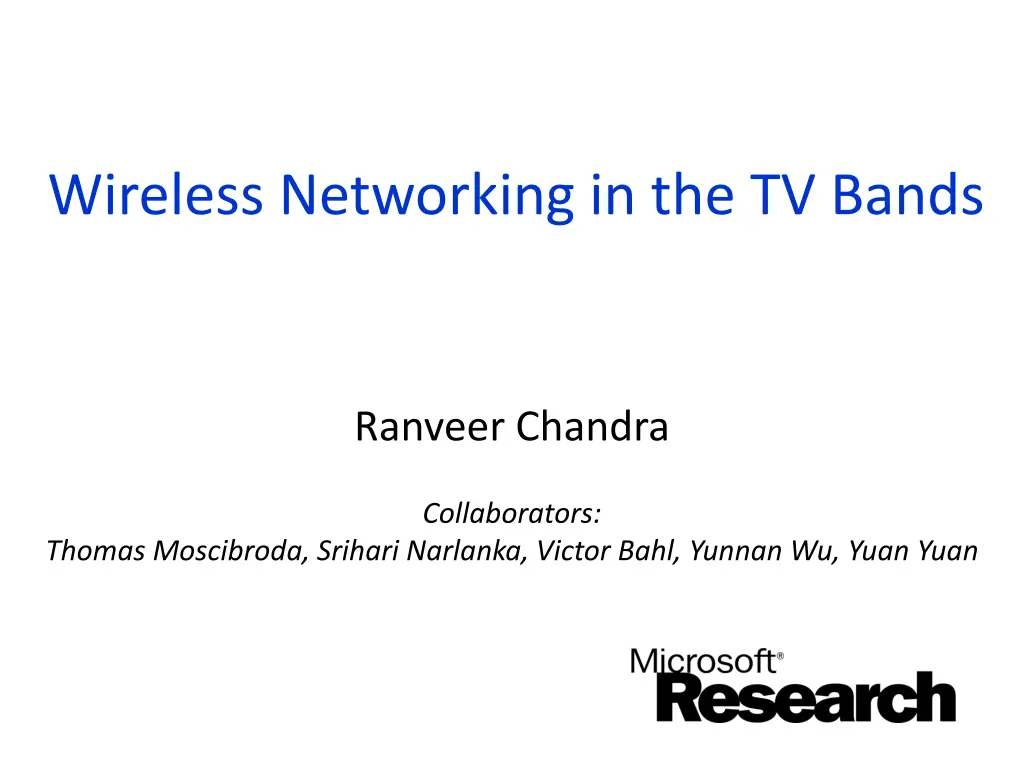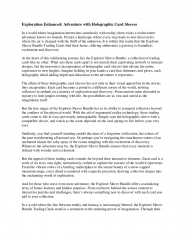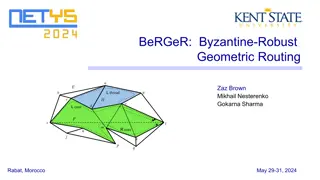
Wireless Networking in TV Bands: Challenges and Solutions
Explore the realm of wireless networking in TV bands, delving into the motivation behind utilizing TV frequencies, FCC regulations, cognitive radios, hidden terminal challenges, and strategies to maximize spectrum utilization. Discover the innovative approaches and technologies shaping the future of wireless communication in TV bands.
Download Presentation

Please find below an Image/Link to download the presentation.
The content on the website is provided AS IS for your information and personal use only. It may not be sold, licensed, or shared on other websites without obtaining consent from the author. If you encounter any issues during the download, it is possible that the publisher has removed the file from their server.
You are allowed to download the files provided on this website for personal or commercial use, subject to the condition that they are used lawfully. All files are the property of their respective owners.
The content on the website is provided AS IS for your information and personal use only. It may not be sold, licensed, or shared on other websites without obtaining consent from the author.
E N D
Presentation Transcript
Wireless Networking in the TV Bands Ranveer Chandra Collaborators: Thomas Moscibroda, Srihari Narlanka, Victor Bahl, Yunnan Wu, Yuan Yuan
Motivation Number of wireless devices in ISM bands increasing Wi-Fi, Bluetooth, WiMax, City-wide Mesh, Increasing interference performance loss Other portions of spectrum are underutilized Example: TV-Bands -60 White spaces dbm -100 750 MHz Frequency 470 MHz
Motivation FCC approved NPRM in 2004 to allow unlicensed devices to use unoccupied TV bands Rule still pending Mainly looking at frequencies from 512 to 698 MHz Except channel 37 Requires smart radio technology Spectrum aware, not interfere with TV transmissions
Cognitive (Smart) Radios 1. Dynamically identify currently unused portions of spectrum 2. Configure radio to operate in available spectrum band take smart decisions how to share the spectrum Signal Strength Signal Strength Frequency Frequency
Challenges Hidden terminal problem in TV bands 518 524 MHz 521 MHz interference TV Coverage Area
Challenges Hidden terminal problem in TV bands Maximize use of fragmented spectrum Could be of different widths -60 White spaces dbm -100 750 MHz Frequency 470 MHz
Challenges Hidden terminal problem in TV bands Maximize use of available spectrum Coordinate spectrum availability among nodes Signal Strength Signal Strength Frequency Frequency
Challenges Hidden terminal problem in TV bands Maximize use of available spectrum Coordinate spectrum availability among nodes MAC to maximize spectrum utilization Physical layer optimizations Policy to minimize interference Etiquettes for spectrum sharing
DySpan 2007, LANMAN 2007, MobiHoc 2007 Our Approach: KNOWS Maximize Spectrum Utilization [MobiHoc 07] Coordinate spectrum availability [DySpan 07] Reduces hidden terminal, fragmentation [LANMAN 07]
Outline Networking in TV Bands KNOWS Platform the hardware CMAC the MAC protocol B-SMART spectrum sharing algorithm Future directions and conclusions
Hardware Design Send high data rate signals in TV bands Wi-Fi card + UHF translator Operate in vacant TV bands Detect TV transmissions using a scanner Avoid hidden terminal problem Detect TV transmission much below decode threshold Signal should fit in TV band (6 MHz) Modify Wi-Fi driver to generate 5 MHz signals Utilize fragments of different widths Modify Wi-Fi driver to generate 5-10-20-40 MHz signals
Operating in TV Bands DSP Routines detect TV presence Scanner UHF Translator Wireless Card Modify driver to operate in 5- 10-20-40 MHz Set channel for data communication Transmission in the TV Band
KNOWS: Salient Features Prototype has transceiver and scanner Data Transceiver Antenna Scanner Antenna Use scanner as receiver on control channel when not scanning
KNOWS: Salient Features Can dynamically adjust channel-width and center-frequency. Low time overhead for switching (~0.1ms) can change at very fine-grained time-scale Transceiver can tune to contiguous spectrum bands only! Frequency
Changing Channel Widths Scheme 1: Turn off certain subcarriers ~ OFDMA 20 MHz 10 MHz Issues: Guard band? Pilot tones? Modulation scheme?
Changing Channel Widths Scheme 2: reduce subcarrier spacing and width! Increase symbol interval 20 MHz 10 MHz Properties: same # of subcarriers, same modulation
Adaptive Channel-Width 20Mhz 5Mhz Why is this a good thing ? Frequency 1. Fragmentation White spaces may have different sizes Make use of narrow white spaces if necessary 2. Opportunistic, load-aware channel allocation Few nodes: Give them wider bands! Many nodes: Partition the spectrum in narrower bands
Outline Networking in TV Bands KNOWS Platform the hardware CMAC the MAC protocol B-SMART spectrum sharing algorithm Future directions and conclusions
MAC Layer Challenges Crucial challenge from networking point of view: How should nodes share the spectrum? Which spectrum-band should two cognitive radios use for transmission? 1. Channel-width ? 2. Frequency ? 3. Duration ? Determines network throughput and overall spectrum utilization! We need a protocol that efficiently allocates time-spectrum blocks in the space!
Allocating Time-Spectrum Blocks View of a node v: Frequency Primary users f+ f f Time t t+ t Node v s time-spectrum block Neighboring nodes time-spectrum blocks Time-Spectrum Block Within a time-spectrum block, any MAC and/or communication protocol can be used ACK ACK ACK
Context and Related Work Context: Single-channel IEEE 802.11 MAC allocates on time blocks Multi-channel Time-spectrum blocks have fixed channel- width Cognitive channels with variable channel-width! time Multi-Channel MAC-Protocols: [SSCH, Mobicom 2004], [MMAC, Mobihoc 2004], [DCA I-SPAN 2000], [xRDT, SECON 2006], etc MAC-layer protocols for Cognitive Radio Networks: [Zhao et al, DySpan 2005], [Ma et al, DySpan 2005], etc Regulate communication of nodes on fixed channel widths
CMAC Overview Use common control channel (CCC) [900 MHz band] Contend for spectrum access Reserve time-spectrum block Exchange spectrum availability information (use scanner to listen to CCC while transmitting) Maintain reserved time-spectrum blocks Overhear neighboring node s control packets Generate 2D view of time-spectrum block reservations
CMAC Overview Sender Receiver RTS Indicates intention for transmitting Contains suggestions for available time- spectrum block (b-SMART) RTS CTS DTS Waiting Time CTS Spectrum selection (received-based) (f, f, t, t) of selected time-spectrum block t DATA Time-Spectrum Block ACK DATA DTS Data Transmission reServation Announces reserved time-spectrum block to neighbors of sender ACK DATA ACK t+ t
Network Allocation Matrix (NAM) Nodes record info for reserved time-spectrum blocks Time-spectrum block Frequency Control channel IEEE 802.11-like Congestion resolution Time The above depicts an ideal scenario 1) Primary users (fragmentation) 2) In multi-hop neighbors have different views
Network Allocation Matrix (NAM) Nodes record info for reserved time-spectrum blocks Primary Users Frequency Control channel IEEE 802.11-like Congestion resolution Time The above depicts an ideal scenario 1) Primary users (fragmentation) 2) In multi-hop neighbors have different views
B-SMART Which time-spectrum block should be reserved ? How long ? How wide ? B-SMART (distributed spectrum allocation over white spaces) Design Principles B: Total available spectrum N: Number of disjoint flows 1. Try to assign each flow blocks of bandwidth B/N 2. Choose optimal transmission duration t Short blocks: More congestion on control channel Long blocks: Higher delay
B-SMART Upper bound Tmax~10ms on maximum block duration Nodes always try to send for Tmax 1. Find smallest bandwidth b for which current queue-length is sufficient to fill block b Tmax b b= B/N Tmax Tmax 2. If b B/N then b := B/N 3. Find placement of bx t block that minimizes finishing time and does not overlap with any other block 4. If no such block can be placed due prohibited bands then b := b/2
Example Number of valid reservations in NAM estimate for N Case study: 8 backlogged single-hop flows Tmax 80MHz 8 (N=8) 2 (N=8) 1 (N=8) 3 (N=8) 4 (N=4) 2(N=2) 5(N=5) 40MHz 7(N=7) 1 (N=1) 3 (N=3) 6 (N=6) 1 2 3 4 5 6 7 8 1 2 3 Time
B-SMART How to select an ideal Tmax ? Let be maximum number of disjoint channels (with minimal channel-width) We define Tmax:= T0 TO: Average time spent on one successful handshake on control channel Nodes return to control channel slower than handshakes are completed Prevents control channel from becoming a bottleneck! We estimate N by #reservations in NAM based on up-to-date information adaptive! We can also handle flows with different demands (only add queue length to RTS, CTS packets!)
Performance Analysis Markov-based performance model for CMAC/B-SMART Captures randomized back-off on control channel B-SMART spectrum allocation We derive saturation throughput for various parameters Does the control channel become a bottleneck ? If so, at what number of users ? Impact of Tmax and other protocol parameters Even for large number of flows, control channel can be prevented from becoming a bottleneck Provides strong validation for our choice of Tmax Analytical results closely match simulated results
Simulation Results - Summary Simulations in QualNet Various traffic patterns, mobility models, topologies B-SMART in fragmented spectrum: When #flows small total throughput increases with #flows When #flows large total throughput degrades very slowly B-SMART with various traffic patterns: Adapts very well to high and moderate load traffic patterns With a large number of very low-load flows performance degrades ( Control channel)
KNOWS in Mesh Networks Aggregate Throughput of Disjoint UDP flows 90 80 70 60 Throughput (Mbps) 2 40MHz 50 4 20MHz 8 10MHz 40 16 5MHz KNOWS 30 20 b-SMART finds the best allocation! 10 0 0 5 10 15 20 25 # of flows
Summary Possible to build hardware that does not interfere with TV transmissions CMAC uses control channel to coordinate among nodes B-SMART efficiently utilizes available spectrum by using variable channel widths
Future Work & Open Problems Integrate B-SMART into KNOWS Address control channel vulnerability Integrate signal propagation properties of different bands Build, demonstrate large mesh network!
Allocating Dynamic Time-Spectrum Blocks in Cognitive Radio Networks $ Victor Bahl Ranveer Chandra Thomas Moscibroda Yunnan Wu Yuan Yuan
Cognitive Radio Networks Number of wireless devices in the ISM bands increasing Wi-Fi, Bluetooth, WiMax, City-wide Mesh, Increasing amount of interference performance loss Other portions of spectrum are underutilized Example: TV-Bands $ -60 White spaces dbm -100 750 MHz Frequency 470 MHz Thomas Moscibroda, Microsoft Research
Cognitive Radios Dynamically identify currently unused portions of the spectrum Configure radio to operate in free spectrum band take smart (cognitive?) decisions how to share the spectrum 1. 2. $ Signal Strength Signal Strength Frequency Frequency Thomas Moscibroda, Microsoft Research
KNOWS-System This work is part of our KNOWS project at MSR (Cognitive Networking over White Spaces) [see DySpan 2007] Data Transceiver Antenna $ Scanner Antenna Prototype has transceiver and scanner Can dynamically adjust center-frequency and channel- width Thomas Moscibroda, Microsoft Research
KNOWS System Can dynamically adjust channel-width and center- frequency. Low time overhead for switching (~0.1ms) can change at very fine-grained time-scale $ Transceiver can tune to contiguous spectrum bands only! Frequency Thomas Moscibroda, Microsoft Research
Adaptive Channel-Width 20Mhz 5Mhz Why is this a good thing ? Fragmentation 1. Frequency White spaces may have different sizes Make use of narrow white spaces if necessary $ Opportunistic and load-aware channel allocation Few nodes: Give them wider bands! Many nodes: Partition the spectrum in narrower bands 2. Thomas Moscibroda, Microsoft Research
Cognitive Radio Networks - Challenges Crucial challenge from networking point of view: How should nodes share the spectrum? Which spectrum-band should two cognitive radios use for transmission? 1. Channel-width ? 2. Frequency ? 3. Duration ? $ Determines network throughput and overall spectrum utilization! We need a protocol that efficiently allocates time-spectrum blocks in the space! Thomas Moscibroda, Microsoft Research
Allocating Time-Spectrum Blocks View of a node v: Frequency Primary users f+ f f $ Time t t+ t Node v s time-spectrum block Neighboring nodes time-spectrum blocks Time-Spectrum Block Within a time-spectrum block, any MAC and/or communication protocol can be used ACK ACK ACK Thomas Moscibroda, Microsoft Research
Cognitive Radio Networks - Challenges Modeling Challenges: In single/multi-channel systems, some graph coloring problem. With contiguous channels of variable channel-width, coloring is not an appropriate model! Need new models! Practical Challenges: Heterogeneity in spectrum availability Fragmentation Protocol should be - distributed, efficient - load-aware - fair - allow opportunistic use Protocol to run in KNOWS $ Theoretical Challenges: New problem space Tools ? Efficient algorithms ? Thomas Moscibroda, Microsoft Research
Contributions Outline 1. Formalize the Problem theoretical framework for dynamic spectrum allocation in cognitive radio networks 2. Study the Theory Dynamic Spectrum Allocation Problem complexity & centralized approximation algorithm $ 3. Practical Protocol: B-SMART efficient, distributed protocol for KNOWS theoretical analysis and simulations in QualNet Thomas Moscibroda, Microsoft Research
Context and Related Work Context: Single-channel IEEE 802.11 MAC allocates only time blocks Multi-channel Time-spectrum blocks have pre-defined channel-width Cognitive channels with variable channel-width! time $ Multi-Channel MAC-Protocols: [SSCH, Mobicom 2004], [MMAC, Mobihoc 2004], [DCA I-SPAN 2000], [xRDT, SECON 2006], etc MAC-layer protocols for Cognitive Radio Networks: [Zhao et al, DySpan 2005], [Ma et al, DySpan 2005], etc Regulate communication of nodes on fixed channel widths Thomas Moscibroda, Microsoft Research
Problem Formulation Network model: Set of n nodes V={v1, , vn} in the plane Total available spectrum S=[fbot,ftop] Some parts of spectrum are prohibited (used by primary users) Nodes can dynamically access any contiguous, available spectrum band $ Simple traffic model: Demand Dij(t, t) between two neighbors vi and vj vi wants to transmit Dij(t, t) bit/s to vj in [t,t+ t] Demands can vary over time! Goal: Allocate non-overlapping time-spectrum blocks to nodes to satisfy their demand! Thomas Moscibroda, Microsoft Research
Time-Spectrum Block Frequency f+ f If node vi is allocated time-spectrum block B Amount of data it can transmit is f Time t+ t t $ Overhead (protocol overhead, switching time, coding scheme, ) Channel-Width Signal propagation properties of band Time Duration Capacity linear in the channel-width In this paper: Constant-time overhead for switching to new block Thomas Moscibroda, Microsoft Research
Can be separated in: Time Frequency Space Problem Formulation Dynamic Spectrum Allocation Problem: Given dynamic demands Dij(t, t), assign non-interfering time-spectrum blocks to nodes, such that the demands are satisfied as much as possible. Interference Model: Problem can be studied in any interference model! Captures MAC-layer and spectrum allocation! $ Different optimization functions are possible: Total throughput maximization -proportionally-fair throughput maximization 1. Min max fair over any time- window 2. Throughput Tij(t, t) of a link in [t,t+ t] is minimum of demand Dij(t, t) and capacity C(B) of allocated time-spectrum block Thomas Moscibroda, Microsoft Research






















